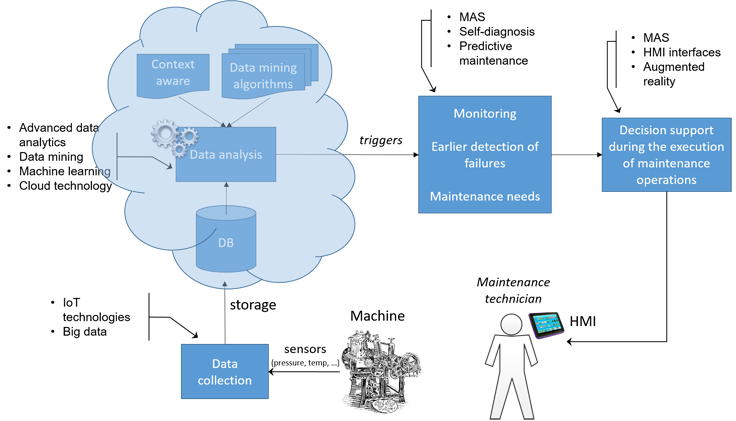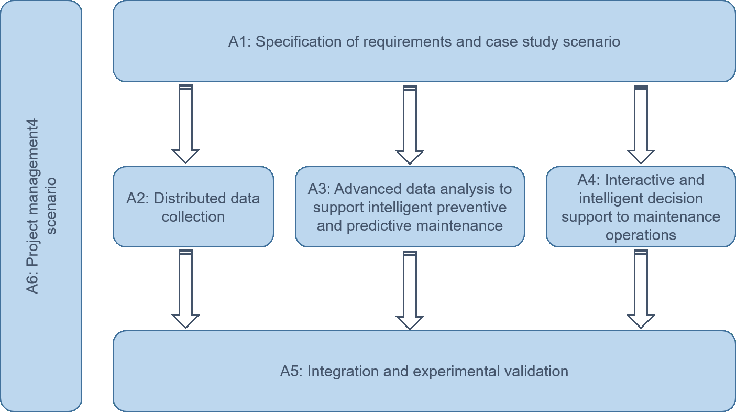
Within the production reality maintenance is crucial to ensure the production efficiency, since the occurrence of failures leads to a degradation of the system performance, causing the loss of productivity. Traditionally, the implementation of maintenance strategies does not consider the huge amount of data being generated in the shop floor and the emergent ICT technologies, e.g., Internet of Things, Big data, advanced data analytics, cloud computing and augmented reality.
Maintenance 4.0 project intends to contribute for the development of a new intelligent and predictive maintenance approach, comprising applied R&D activities focusing the experimental proof-of-concept of new applications based on emergent ICT technologies, developing a prototype to be tested in laboratorial and industrial environments.
The project will introduce intelligent and predictive mechanisms to support the industrial maintenance, minimizing the effects and impact of unexpected failures in the production system, and consequently increasing the competitiveness of manufacturing enterprises, especially the SMEs (Small and Medium Enterprises) where the environment volatility is higher.
Maintenance 4.0 idea, depicted in the picture bellow, comprises data collection using Big Data and IoT technologies, advanced data analysis by the use of data mining, machine learning and cloud technologies and early detection of failures and a decision support system implemented by the integration of predictive maintenance algorithms and augmented reality, respectively. All these technologies will interact with the operator through a Human-Machine Interface (HMI).

In short, Maintenance 4.0 project aims to develop an intelligent approach for the industrial maintenance, aligned with Industry 4.0 principles, that:
• Considers advanced analysis of the data collected from the shop floor to monitor and detect earlier the occurrence of disturbances at shop floor and consequently the need to implement maintenance interventions.
• Supports the maintenance technician during the maintenance interventions by providing a guided intelligent decision support articulated by the use of human-machine interaction technologies.
This approach will contribute to reduce the unplanned production downtime and to optimize the maintenance interventions, and will be evaluated in Catraport, an industrial metal stamping production unit.
The scientific objectives of Maintenance 4.0 project are set to allow the development of a functional system of decision support to assist the operators to perform maintenance tasks and to implement predictive maintenance on the shop floor. This system integrates different technologies such as distributed data collection, advanced data analysis and interactive and intelligent decision support. These technologies will be integrated in one system and then implemented and validated in the industrial study case.
Distributed data collection
Nowadays, a huge amount of valuable data is generated at shop floor, which typically, is not gathered or is simply ignored. In order to collect all valuable data is mandatory to have systems that are able to collect information available on the machines and the operators’ knowledge.
The information contained in the machines is crucial since it is information that concerns the failures, therefore a distributed data collection from shop floor machines is needed. This will be accomplished by the use of Internet of Things (IoT) technology, which provides an innovative way towards the distributed data collection by using, normally, lightweight communication protocols, e.g., MQTT (Message Queuing Telemetry Transport). Furthermore, the data collection from PLCs is usually necessary in industrial automation systems, which may require the use of OPC-UA (OPC Unified Architecture) technology.
Also, throughout the daily use of machines, operators accumulate valuable knowledge, which is usually not collected, but may offer important information to the system operation since “no one knows better its machine than the operator”. A graphical interface for a smooth data insertion from the operator is a simple accessory that allows the operator to register the knowledge. The Human-Machine Interface (HMI) must be developed considering the ergonomic aspects to enable a more efficient and friendly human-machine interface. Another important aspect is the data storage, which will be performed in a first level near the machines where data is collected, and following the edge computing paradigm, to ensure real time data processing. At a second level, a cloud-based data storage is used to support optimized data analysis.
Advanced data analysis to support intelligent preventive and predictive maintenance
Problematic situations resulting from the machines’ operation are usually hard to detect, and contribute, in a critical manner, to increase the Overall Equipment Effectiveness (OEE). In this way, an advanced data analysis system that allows the monitoring and early detection of machine failures, supporting preventive and predictive maintenance tasks in a dynamic and automatic way is essential.
The collected data will be analysed in a two-step manner. First, a short-term data analysis comprising fast computation algorithms, to empower machines with responsiveness to detect earlier abnormal operating conditions and self-diagnosis capabilities, these algorithms may use rule-base mechanisms combined with data mining to check the compliance with threshold values, issuing warnings in case of boundaries violation. Secondly, a long-term data analysis to enable predicting beforehand the need to implement maintenance actions aiming to reduce the machines downtime. Long-term analysis, such as trend detection or multiple information data correlation, will ensure an optimized maintenance strategy since the fast reaction is not a mandatory issue. At this level, more sophisticated and intelligent data analysis allied with machine learning algorithms need to be considered. The short-term and the long-term data analysis should be balanced in an effective way, for this purpose a symbiotic coordination of low level data analysis, providing fast reaction, with the higher level data analysis, providing long-term and optimized reaction, supports an innovative and much more efficient maintenance strategy.
Interactive and intelligent decision support to maintenance operations
The execution of maintenance operations is normally complex and requires high-level expertise from the maintenance technicians to execute these operations in short time, with the necessary quality and with the minimal impact on the normal production cycles. The use of new technologies, such as expert systems, data mining and augmented reality, can be helpful to support the technicians during the realization of maintenance operations.
To accomplish this a decision support application, to guide the technicians by selecting the correct maintenance procedure, is necessary. For this purpose, machine learning algorithms, complemented with rule-based engines, will properly diagnose the machine symptoms and derive the proper selection of the maintenance procedure. Furthermore, a HMI to assist the technicians during the maintenance procedure is essential. The use of augmented reality will provide a natural interface between the intelligent application and the maintenance technician. Hand-held devices, such as tablets, may offer an alternative for this interface. Ergonomic issues are crucial in the development of such interfaces, influencing the selection of the devices used to display the information.
The Maintenance 4.0 project will last 18 months (October 1st, 2017 – April 1st, 2019) and it comprehends six activities.

Activity 1 is a crucial activity for setting the specification of requirements and the case study scenario.
Activity 2, 3 and 4 receive the input from Activity 1 and the output of this activities will be the input for Activity 5, where the applications will be integrated and validated.
• Activity 2 provides the distributed data collection system.
• Activity 3 implements an advanced data analytics approach to support preventive and predictive maintenance.
• Activity 4 creates an interactive and intelligent decision support to maintenance operations.
Activity 5 is specifically devoted to the use case. This activity manages the integration and validation of the developed applications and systems.
Activity 6 covers the project management and coordination.
